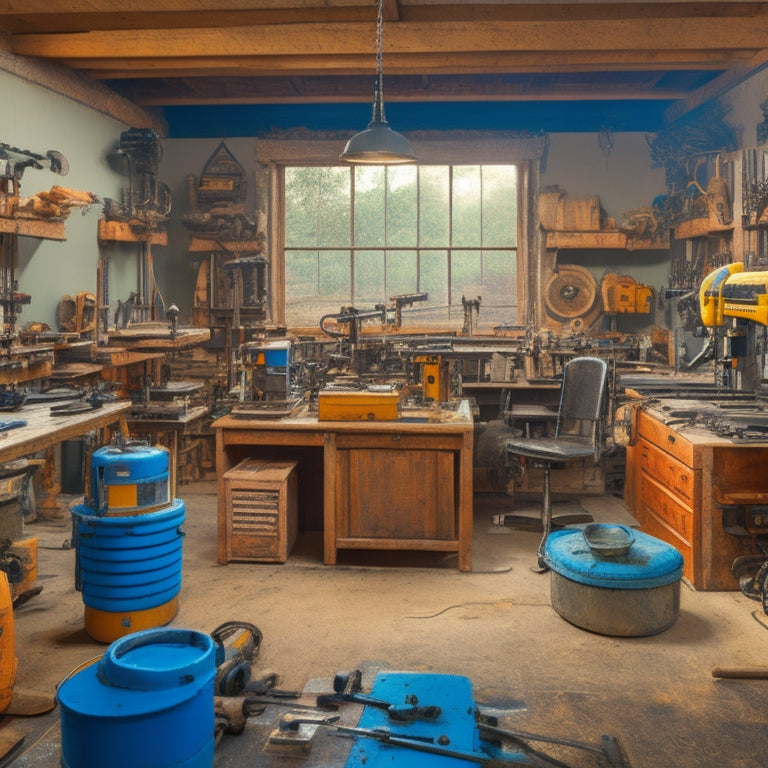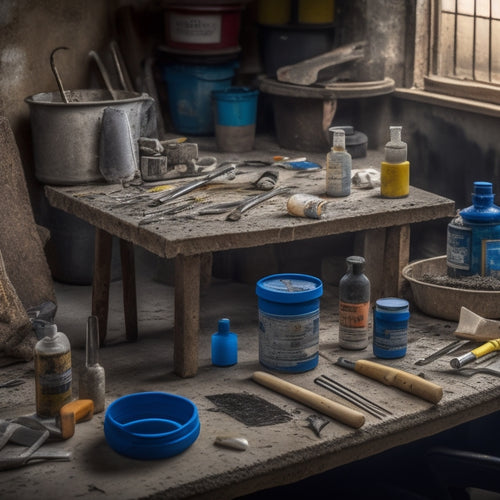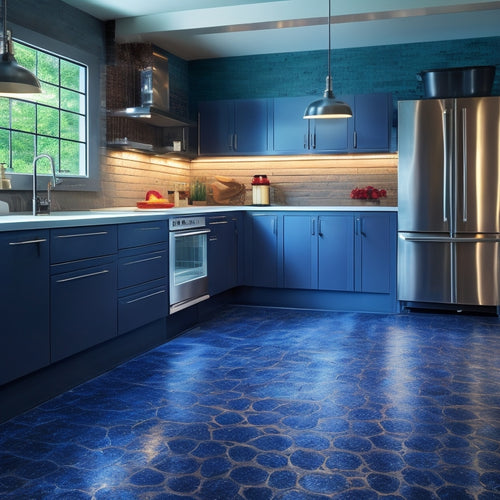
Ultimate Guide to Manufacturing Equipment for Home Renovation
Share
You're about to initiate your journey into the complex world of manufacturing equipment for home renovation, where understanding the intricacies of concrete block production can make all the difference in delivering premium results. From concrete block design and mixing to curing and laying, each stage requires specialized equipment and precision processes. You'll need to navigate block strength analysis, material handling efficiency, and block laying techniques, while also considering automation, safety precautions, and equipment maintenance. As you embark on this journey, you'll discover the importance of each element in producing high-quality concrete blocks that meet your project's specifications and standards, setting you up for success in your home renovation projects.
Key Takeaways
• Understanding concrete block manufacturing equipment is crucial for informed material and equipment choices in home renovation projects.
• The concrete block production process involves designing blocks, preparing the concrete mix, pouring, curing, and quality inspections.
• Mixing ratio considerations, such as cement-to-aggregate and water-to-cement ratios, significantly impact block strength and durability.
• Investing in quality molds and accessories, such as block laying and handling machines, ensures high-quality blocks that meet project specifications.
• Automation and efficiency in manufacturing equipment, like block curing and testing tools, can significantly boost productivity and reduce labor costs.
Concrete Block Manufacturing Overview
You'll find that concrete block manufacturing involves a combination of raw materials, specialized equipment, and precision processes to produce high-quality blocks for various construction applications.
As you explore this process, you'll discover that block design trends play an essential role in meeting specific project requirements. From sleek, modern designs to traditional, rustic styles, the versatility of concrete blocks allows for endless possibilities.
Additionally, the increasing demand for sustainable materials has led manufacturers to incorporate eco-friendly alternatives into their production lines. This shift towards sustainability not only reduces environmental impact but also appeals to environmentally conscious consumers.
By understanding the intricacies of concrete block manufacturing, you'll be better equipped to make informed decisions about the materials and equipment needed for your home renovation project.
Concrete Block Mixing Equipment Checklist
When setting up your concrete block mixing equipment, you'll need to take into account several key factors to guarantee optimal production.
You'll want to determine the ideal mixing ratio for your specific application, analyze the strength of the resulting blocks, and enhance material handling efficiency to minimize waste and maximize output.
Mixing Ratio Considerations
Accurately setting the mixing ratio of cement, aggregate, and water is essential to producing high-quality concrete blocks that meet the required strength and durability standards. You must consider the type of cement, aggregate size and shape, and water quality to achieve ideal ratios.
Improper mixing ratios can lead to weak or brittle blocks, affecting the overall structure's integrity.
When setting the mixing ratio, consider the following:
-
Cement-to-aggregate ratio: Aim for an ideal ratio of 1:6 to 1:8 to guarantee strong bonds between cement and aggregate.
-
Water-to-cement ratio: Keep this ratio between 0.4 and 0.6 to achieve the right consistency and prevent excessive water absorption.
-
Aggregate size and shape: Select aggregate with a consistent size and shape to guarantee uniform mixing and strength distribution.
- Mixing techniques: Use efficient mixing techniques, such as paddle mixing or pan mixing, to guarantee thorough blending and minimize segregation.
Block Strength Analysis
With the mixing ratio set, you're ready to analyze the block strength using the right concrete block mixing equipment. This involves checking off a series of critical parameters to confirm the produced blocks meet the required standards.
To guarantee ideal block performance, you'll need to evaluate various block performance metrics, including compressive strength, density, and water absorption. These metrics will provide valuable insights into the block's structural integrity and durability.
During the structural integrity analysis, pay close attention to the block's resistance to cracking, breaking, and deformation. This will help you identify potential weaknesses and make necessary adjustments to the mixing process.
Additionally, assess the block's dimensional stability, confirming it meets the required tolerances and specifications.
Material Handling Efficiency
You'll need to optimize material handling efficiency by streamlining the concrete block mixing equipment's workflow, ensuring that each component is strategically positioned to minimize downtime and maximize production. This involves analyzing the material flow and identifying bottlenecks that hinder the logistics optimization process. By doing so, you'll be able to reduce labor costs, decrease material waste, and increase overall productivity.
To achieve the best material handling efficiency, consider the following:
-
Component placement: Position each component in a way that minimizes transportation distances and reduces congestion.
-
Material storage: Designate specific areas for material storage, ensuring easy access and minimizing handling times.
-
Workstation ergonomics: Design workstations that promote efficient material handling, reducing fatigue and increasing worker productivity.
- Automated systems integration: Integrate automated systems, such as conveyor belts or robotic arms, to streamline material handling and reduce labor costs.
Concrete Block Molds and Accessories
Concrete block molds, fabricated from durable materials like steel or polypropylene, enable you to cast uniform, high-strength blocks for your home renovation projects. You can choose from various mold types, including standard, corner, and cap molds, to create blocks that fit your specific needs. Additionally, you can explore accessory options to enhance the functionality of your molds.
| Mold Type | Description | Material |
|---|---|---|
| Standard Molds | For casting standard rectangular blocks | Steel or Polypropylene |
| Corner Molds | For casting corner blocks with a 90-degree angle | Steel or Polypropylene |
| Cap Molds | For casting cap blocks with a flat top | Steel or Polypropylene |
| Specialty Molds | For casting blocks with unique shapes or designs | Steel or Polypropylene |
When selecting a mold, consider factors such as the size and shape of the blocks you need, the strength requirements, and the material you're working with. By investing in the right concrete block molds and accessories, you can guarantee that your blocks are of high quality and meet your project's specifications. With the right tools, you can take your home renovation project to the next level.
Block Laying and Handling Machines
When it comes to block laying and handling machines, you'll need to assess the type of machine that best suits your home renovation project.
You'll want to evaluate the different machine types, such as manual, semi-automatic, and fully automatic, and determine how they can be used to improve your block laying techniques.
Machine Types and Uses
Your block laying and handling machines are designed to streamline the process of placing and moving heavy materials around the construction site.
These machines are essential for efficient block laying, reducing labor costs, and increasing productivity.
When it comes to machine types and uses, you'll find a range of options to suit your specific needs. Here are four key machine types to evaluate:
-
Block cutting machines: These machines are designed to precision-cut blocks to the required size, ensuring a perfect fit and minimizing waste.
-
Block handling machines: These machines are used to move and place blocks around the construction site, reducing manual labor and the risk of injury.
-
Finishing tools: These machines are used to finish and refine block surfaces, providing a smooth and even finish.
- Material handling equipment: These machines are used to transport and store blocks, ensuring they're readily available when needed.
Block Laying Techniques
By mastering various block laying techniques, you can enhance the performance of your block laying and handling machines, guaranteeing efficient and accurate block placement on the construction site. As you work with these machines, it's important to understand the different techniques that can improve their performance.
One significant technique is ideal jointing, which involves aligning blocks to minimize joints and create a strong, stable structure. You should also consider the type of block being laid, as different materials require unique handling and placement methods. For instance, concrete blocks often require a slightly different approach than clay blocks.
Additionally, understanding the importance of level and plumb in block laying is crucial to guarantee a straight and even structure. By mastering these block laying techniques, you'll be able to achieve precise block placement, reduce waste, and increase the overall quality of your construction project.
With practice and patience, you'll be able to enhance your block laying and handling machines, taking your construction project to the next level.
Automation and Efficiency
With the advent of advanced technology, you can markedly boost the productivity of your block laying and handling machines by incorporating automation features that streamline tasks, reduce manual labor, and optimize workflow.
By leveraging automation trends, you can achieve significant efficiency improvements, making your renovation projects more cost-effective and timely.
Here are four key areas where automation can make a significant impact:
-
Machine Learning Algorithms: Implementing machine learning algorithms can enable your block laying machines to learn from experience, adapt to new patterns, and optimize their performance over time.
-
Robotics Integration: Integrating robots into your block laying process can automate tasks such as material handling, reducing the risk of human error and increasing overall efficiency.
-
Automated Quality Control: Automation can help you implement real-time quality control checks, ensuring that every block is laid to precision and reducing the need for manual inspections.
- Data Analytics: By collecting and analyzing data on your block laying process, you can identify areas for improvement, optimize your workflow, and make data-driven decisions to drive efficiency improvements.
Concrete Block Curing Equipment Guide
You'll need reliable concrete block curing equipment to guarantee the blocks achieve their desired strength and durability.
Curing is a critical process that involves controlling temperature, humidity, and moisture to facilitate proper hydration of cement. To achieve ideal results, you'll need to master various curing techniques, including steam curing, membrane curing, and fogging.
Moisture control is essential in concrete block curing, as excessive moisture can lead to weak and brittle blocks. You'll need to invest in equipment that can maintain the ideal moisture levels, such as curing chambers, misting systems, and hydration monitoring devices. These tools will help you create a controlled environment that promotes uniform curing and prevents defects.
When selecting concrete block curing equipment, consider factors like capacity, precision, and ease of use. Look for equipment that can be easily integrated into your existing production line and provides real-time monitoring and control capabilities.
Block Testing and Inspection Tools
Eight distinct block testing and inspection tools are vital to verify the quality and performance of your concrete blocks, ensuring they meet the required specifications and standards. You'll need these tools to conduct thorough evaluations and identify any defects or irregularities in your blocks.
Here are four essential block testing and inspection tools you should consider:
-
Compression testing machine: Measures the compressive strength of your concrete blocks, ensuring they can withstand the required loads.
-
Density measurement device: Determines the density of your blocks, which affects their strength, durability, and overall performance.
-
Surface absorption test equipment: Evaluates the water absorption rate of your blocks, which is critical for evaluating their resistance to weathering and erosion.
- Visual inspection tools: Enables you to examine your blocks for any visible defects, such as cracks, chips, or uneven surfaces.
Concrete Block Production Process
To produce high-quality concrete blocks, you must follow a meticulous concrete block production process that involves several critical steps.
First, you'll need to design your blocks, taking into account current block design trends and the specific requirements of your project. This includes determining the block's size, shape, and texture, as well as selecting suitable sustainable materials that meet your environmental and budgetary needs.
Next, you'll need to prepare the concrete mix, which involves combining cement, aggregate, and water in the correct proportions. The mix should be consistent and of high quality to guarantee that your blocks are strong and durable.
Once the mix is ready, you can begin pouring it into molds, which should be clean and well-lubricated to prevent the blocks from sticking.
After the blocks have been poured, you'll need to allow them to cure, either naturally or using specialized equipment to accelerate the process.
Finally, you can remove the blocks from the molds and begin inspecting them for quality and defects.
Block Manufacturing Safety Precautions
During the concrete block manufacturing process, it's essential that you take specific safety precautions to minimize risks and prevent accidents. You'll be working with heavy machinery, raw materials, and potentially hazardous substances, so it's vital to prioritize your safety and the safety of your team.
To guarantee a safe working environment, follow these guidelines:
-
Wear necessary safety gear: Hard hats, safety glasses, gloves, and steel-toed boots are a must to protect yourself from falling objects, flying debris, and other hazards.
-
Follow health regulations: Familiarize yourself with local health regulations and make certain that your manufacturing process complies with them. This includes proper ventilation, waste disposal, and handling of hazardous materials.
-
Conduct regular equipment maintenance: Regularly inspect and maintain your equipment to prevent mechanical failures that can lead to accidents.
- Provide training and supervision: Make sure that all team members are properly trained and supervised to handle equipment and materials safely.
Concrete Block Equipment Maintenance Tips
Regularly scheduling concrete block equipment maintenance checks helps prevent unexpected downtime and costly repairs.
As you implement block maintenance strategies, you'll reduce the risk of equipment failure and extend its lifespan. Start by creating a preventive maintenance schedule, outlining tasks to be performed daily, weekly, and monthly.
During these checks, inspect the equipment for signs of wear and tear, such as worn-out belts, damaged molds, and corroded metal parts. Lubricate moving parts, clean the machinery, and replace worn-out components promptly.
Additionally, train your operators to perform routine checks and report any issues to the maintenance team. By doing so, you'll identify potential problems early on and address them before they escalate into major repairs.
Furthermore, keep accurate records of maintenance activities, including repairs, replacements, and adjustments. This will help you track equipment performance, identify trends, and optimize your preventive maintenance techniques.
Frequently Asked Questions
Can I Manufacture Concrete Blocks at Home Without Industrial Equipment?
You're wondering if you can manufacture concrete blocks at home without industrial equipment. The answer is yes, but it requires some effort and dedication.
You can create DIY concrete blocks using a mold, cement, sand, and aggregate. Mix the ingredients, pour into the mold, and let it set.
You'll need to make certain the mixture is precise, and the blocks are cured properly.
With patience and practice, you can produce high-quality home blocks for your renovation projects.
What Is the Ideal Storage Temperature for Concrete Block Molds?
As you carefully craft each concrete block, you're building a foundation for success.
Now, it's time to protect that foundation by storing your molds in the ideal temperature.
You're wise to ask, because mold maintenance begins with temperature control.
Aim for a consistent range between 60°F to 80°F (15°C to 27°C) to prevent warping, cracking, and damage.
This sweet spot guarantees your molds remain in top condition, ready to produce high-quality blocks that will stand the test of time.
Are Concrete Block Manufacturing Businesses Profitable?
Are you wondering if concrete block manufacturing businesses are profitable?
The answer lies in understanding profit margins and market demand.
You'll find that profit margins can be substantial, especially if you're producing high-quality blocks in high demand.
Research shows that the global concrete block market is expected to grow considerably, driven by infrastructure development and urbanization.
With the right equipment and strategy, you can capitalize on this trend and reap considerable profits.
Do I Need a License to Start a Concrete Block Manufacturing Business?
Imagine building your concrete block manufacturing business from the ground up - but don't forget the foundation of licensing!
You'll need to check with your local government to determine the necessary business registration and licensing requirements. These vary by state and even city, so do your due diligence.
Obtaining the proper licenses will guarantee you're operating legally and avoid costly fines.
Research and comply with regulations to lay a solid foundation for your business.
Can I Reuse Concrete Block Molds After They've Been Used?
You're wondering if you can reuse concrete block molds after they've been used. The answer is yes, but only if you follow proper mold maintenance.
Reusing molds can reduce production costs and increase efficiency.
To guarantee reuse benefits, clean the molds thoroughly after each use, inspect for damage, and apply a release agent to prevent concrete from sticking.
Conclusion
You've reached the final brick in the wall of concrete block manufacturing equipment knowledge.
Now, it's time to put the pieces together and build a solid foundation for your home renovation project.
Remember, having the right tools is like having a master builder's blueprint - it's the roadmap to success.
With this ultimate guide, you're well-equipped to navigate the complex landscape of concrete block manufacturing and emerge with a sturdy, high-quality final product.
Related Posts
-

3 Best Epoxy-Based Crack Filling Tools for Renovation
When selecting the best epoxy-based crack filling tool for your renovation project, you'll want a reliable and effici...
-

Why Choose Epoxy for Your Floor Renovation Project
When it comes to your floor renovation project, you'll want to evaluate epoxy for its unbeatable combination of benef...
-

What to Inspect in Your Renovation Tool Kit
When inspecting your renovation tool kit, you'll want to start with the concrete mixer, checking the drum, blades, an...


